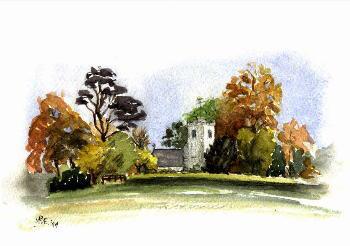Notice Board
Beercrocombe




The origins of the village probably date back to late Saxon times when the original settlement is likely to have been a small scattering of farmsteads created by clearance at the edges of the Neroche Forest.
There are many theories as to the origin of the name but the current spelling is quite recent. In the Domesday Book it is recorded as Bere, which could be derived from the old English baeru - a wood or grove, or baer - a pasture. Beer Crocombe or Beer Crowcombe became the norm from about 1600 but Beere or Beer was still used up to the 1700s. The Crocombe part of the name could derive from associations with other Crocombes in Somerset. One recent suggestion is that it may be a corruption of Beer Crewkerne since it used to be in the Deanery of Crewkerne and the name would have differentiated the place from Beer near Taunton.
Bere prior to the Norman Conquest was one of the possessions of a Saxon landholder called Algar. It paid a Geld or land tax for 5 hides, when a hide was judged to be an area of land sufficient to support a household. Following the Conquest the village became part of the estates of Reginald de Vautorte but he in turn was a sub-tenant of Count Robert de Mortain, half brother of William the Conqueror, who ruled his lands from his castle at Montacute near Yeovil.
No buildings survive from those times and the church dating from the 13th century is the earliest structure. There is no evidence of a manor house in the village and such a building would have been unlikely since Beercrocombe was always part of a much larger land holding. Beercrocombe had several owners after Norman times eventually in the late 1500’s coming into the ownership of the Wadham family of Merryfield, who founded the college of that name in Oxford. Beercrocombe and the rest of the Wadham estates then came by marriage to the Wyndhams in 1572 and remained with that family until 1920 when the estate was parcelled up and auctioned.
St James Church mainly dates from the 15th century but there are 13th century remains of the earlier building. It is thought that John Harewell built the current church. He was given Beercrocombe in 1402 on his marriage to Margery, the daughter of the owner Sir Thomas Beaupyne. There are minor later additions and changes and the church may originally have been thatched. However the church as we see it today is much as was in the early 17th century. Whilst a simple country church St James has many interesting features, for example, the carvings at the base of the archways in the church, known locally as “Hunky-Punks”.
There are many theories as to the origin of the name but the current spelling is quite recent. In the Domesday Book it is recorded as Bere, which could be derived from the old English baeru - a wood or grove, or baer - a pasture. Beer Crocombe or Beer Crowcombe became the norm from about 1600 but Beere or Beer was still used up to the 1700s. The Crocombe part of the name could derive from associations with other Crocombes in Somerset. One recent suggestion is that it may be a corruption of Beer Crewkerne since it used to be in the Deanery of Crewkerne and the name would have differentiated the place from Beer near Taunton.
Bere prior to the Norman Conquest was one of the possessions of a Saxon landholder called Algar. It paid a Geld or land tax for 5 hides, when a hide was judged to be an area of land sufficient to support a household. Following the Conquest the village became part of the estates of Reginald de Vautorte but he in turn was a sub-tenant of Count Robert de Mortain, half brother of William the Conqueror, who ruled his lands from his castle at Montacute near Yeovil.
No buildings survive from those times and the church dating from the 13th century is the earliest structure. There is no evidence of a manor house in the village and such a building would have been unlikely since Beercrocombe was always part of a much larger land holding. Beercrocombe had several owners after Norman times eventually in the late 1500’s coming into the ownership of the Wadham family of Merryfield, who founded the college of that name in Oxford. Beercrocombe and the rest of the Wadham estates then came by marriage to the Wyndhams in 1572 and remained with that family until 1920 when the estate was parcelled up and auctioned.
St James Church mainly dates from the 15th century but there are 13th century remains of the earlier building. It is thought that John Harewell built the current church. He was given Beercrocombe in 1402 on his marriage to Margery, the daughter of the owner Sir Thomas Beaupyne. There are minor later additions and changes and the church may originally have been thatched. However the church as we see it today is much as was in the early 17th century. Whilst a simple country church St James has many interesting features, for example, the carvings at the base of the archways in the church, known locally as “Hunky-Punks”.
• Our Village Hall, updated facilities - tap to enlarge




